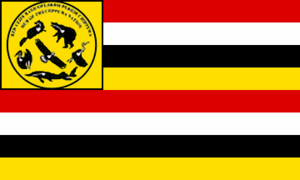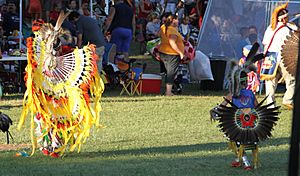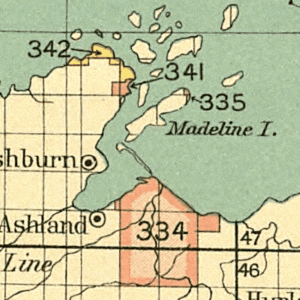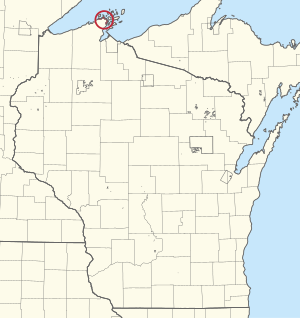Red Cliff Band of Lake Superior Chippewa facts for kids
| Gaa-Miskwaabikaang | |
|---|---|

Flag of the Red Cliff Band
|
|

Red Cliff members in a powwow
|
|
| Total population | |
| 5,312 (2010) | |
| Regions with significant populations | |
| Languages | |
| English, Ojibwe | |
| Related ethnic groups | |
| other Ojibwe people |
The Red Cliff Band of Lake Superior Chippewa (called Ojibwe: Gaa-Miskwaabikaang in their own language) is a group of Ojibwe Native Americans. They live on the Red Cliff Indian Reservation in Wisconsin. This reservation is right on the beautiful shores of Lake Superior. The main town for the Red Cliff Band is Red Cliff, Wisconsin.
The Red Cliff Band is special because they live very close to Madeline Island. This island is a very important spiritual place for the whole Ojibwe nation. In 2010, there were over 5,300 members in the Red Cliff Band. About half of them lived on the reservation. The others lived nearby in Bayfield or the Belanger Settlement.
Contents
A Look at Red Cliff History
The Red Cliff Band is part of the larger Lake Superior Chippewa group. These Ojibwe people slowly moved west. They traveled along the southern shore of Lake Superior from Sault Ste. Marie.
Ojibwe stories say their people came from the Atlantic coast. They stopped in many places along the way. The Great Spirit (Gichi Manidoo) guided them. They were looking for "the food that grows on water," which is wild rice. Madeline Island was their final stopping place.
Early European Contact
In the 1600s, French fur traders and Jesuits came to Madeline Island. They set up a trading post and a Catholic mission there. This place was called La Pointe.
By the 1700s, the La Pointe Ojibwe had spread out. They moved across what is now Wisconsin and Minnesota. The Ojibwe who stayed near Madeline Island were known as the La Pointe Band.
Forming the Reservation
In 1850, the U.S. government tried to move the Lake Superior Ojibwe. This led to a sad event called the Sandy Lake Tragedy. After this, the U.S. government agreed to create permanent reservations in Wisconsin. This agreement was part of the Treaty of La Pointe in 1854.
At this time, the La Pointe band split. Some members were Catholic and followed Chief Buffalo. They chose to live on the Red Cliff reservation. Other members kept their traditional Midewiwin beliefs. They settled at Bad River. Even today, these two bands remain very close.
In the early days of the reservation, many tribal members worked for non-Native employers. They often found jobs in the commercial fishing industry in nearby Bayfield, Wisconsin.
Around the early 1900s, the government allowed logging companies to cut down most of the trees on the reservation. Many tribal members worked in logging. However, the tribe itself did not get much money from these logging profits.
A Time of Revival
During the 1900s, fishing in Lake Superior helped many Red Cliff families. The Ojibwe had kept their rights to hunt, fish, and gather in old treaties. In 1972, a court case called Gurnoe vs. Wisconsin happened. The court decided that a Red Cliff tribal member had the right to catch a fair amount of fish. This was a very important decision for tribal rights.
From 1987 to 1991, there was a time called the Wisconsin Walleye War. Other Ojibwe bands faced violence during this time. But Red Cliff did not have these problems. However, Red Cliff tribal members did start using their treaty rights. A member named Walter Bresette became a big leader in the movement to protect these rights.
Red Cliff Today
Today, the Red Cliff Band runs a fish hatchery. They also have the Legendary Waters Resort and Casino. This resort is right on the shore of Lake Superior. The band also manages the reservation's Head Start program for young children. They even offer a special program to teach young kids the Ojibwe language.
Many talented people come from the Red Cliff Band. Rabbett Strickland is a famous artist. Frank Anakwad Montano is a musician known around the world. He is very good at making and playing Ojibwe flutes. He also plays the guitar.
The Red Cliff Reservation
The Red Cliff Reservation is located on the shore of Lake Superior. It is north of the city of Bayfield, Wisconsin. The main offices for the band are in Red Cliff, Wisconsin.
In 2020, the reservation and nearby trust lands covered about 22.91 square miles. Most of this area is land, with a small part being water.
The 2020 census showed that 1,403 people lived on the reservation and trust lands. Most of the people (82.8%) were Native American. About 11.4% were White. Some people were from two or more races (5.3%). A small number (5.4%) were Hispanic or Latino.
The average income for a family on the reservation was about $41,667. About 34.9% of the people lived below the poverty line. This included 45.0% of children under 18. Most adults (87.3%) had finished high school. About 6.2% had a college degree or higher.
Frog Bay Tribal National Park
In 2012, the Red Cliff Band created the Frog Bay Tribal National Park. This park is on the reservation. It is the first tribal national park in the United States that is open to the public. The park protects about 175 acres of beautiful nature. This includes forests, wetlands, and untouched Lake Superior coastline.
Notable Members
- Kechewaishke (Chief Buffalo)
- Walter Bresette, an activist for the environment and Native American rights




